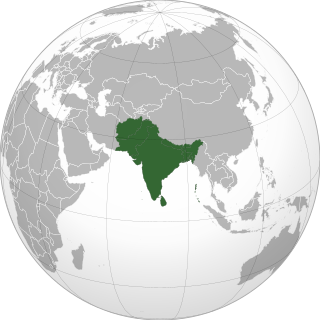
The history of southern India covers a span of over four thousand years during which the region saw the rise and fall of a number of dynasties and empires.

The Pandyan dynasty, also referred to as the Pandyas of Madurai, was an ancient Tamil dynasty of South India, and among the four great kingdoms of Tamilakam, the other three being the Pallavas, the Cholas and the Cheras. Existing since at least the 4th to 3rd centuries BCE, the dynasty passed through two periods of imperial dominance, the 6th to 10th centuries CE, and under the 'Later Pandyas'. Under Jatavarman Sundara Pandyan I and Maravarman Kulasekara Pandyan I, the Pandyas ruled extensive territories including regions of present-day South India and northern Sri Lanka through vassal states subject to Madurai.

The Pallava dynasty existed from 275 CE to 897 CE, ruling a significant portion of the Deccan, also known as Tondaimandalam. The Pallavas played a crucial role in shaping in particular southern Indian history and heritage. The dynasty rose to prominence after the downfall of the Satavahana Empire, whom they had formerly served as feudatories.

Aditya Chola I, the son of Vijayalaya Chola, was the Chola king who laid the foundation of the Chola Empire with the conquest of the Pallava Kingdom and the occupation of the Western Ganga Kingdom and Kongu Nadu. Aditya Chola I was succeeded by his eldest son Parantaka Chola I.

Jatavarman Sundara I, also known as Sadayavarman Sundara Pandyan, was an emperor of the Pandyan dynasty who ruled regions of Tamilakam, Northern Sri Lanka, and Southern Andhra between 1250–1268 CE. He is remembered for his patronage of the arts and Dravidian architecture, along with refurbishment and decoration of many Kovils (temple) in the Tamil continent. He oversaw a massive economic growth of the Pandyan empire. On the eve of his death in 1268 CE, the second Pandyan empire's power and territorial extent had risen to its zenith till Nellore and Kadapa by defeating Telugu Chola rulers Vijaya Gandagopala, Manumasiddhi III of Nellore Cholas and Ganapatideva of Kakatiyas.

Pandya Nadu or Pandi Nadu is a geographical region comprising the southern part of the present day state of Tamil Nadu. The region is bounded on its West by the Venad/Ay Nadu, Northeast by the Chola Nadu and Northwest by the Kongu Nadu. It comprises the present-day districts of Madurai, Theni, Sivaganga, Ramanathapuram, Virudhunagar, Tirunelveli, Tenkasi, Thoothukudi, Kanniyakumari, parts of Pudukkottai and Dindigul.
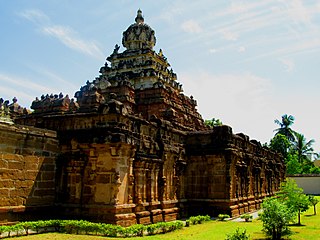
Kanchipuram also known as Kanjeevaram, is a stand alone city corporation, satellite nodal city of Chennai in the Indian state of Tamil Nadu in the Tondaimandalam region, 72 km (45 mi) from Chennai – the capital of Tamil Nadu. Known as the City of Thousand Temples, Kanchipuram is known for its temple architectures, 1000-pillared halls, huge temple towers and silk saris. Kanchipuram serves as one of the most important tourist destinations in India. Kanchipuram has become a centre of attraction for foreign tourists as well. The city covers an area of 36.14 km2 (13.95 sq mi) and an estimated population of more than 13,00,000 in 2021. It is the administrative headquarters of Kanchipuram District. Kanchipuram is well-connected by road and rail.

Karikala, often referred to as Karikala the Great, was a Tamil Emperor of the Early Cholas of the Chola dynasty who ruled ancient Tamilakam from Uraiyur. He is credited with the construction of the flood banks of the river Kaveri and conquest of Tamilakam, Andhra and Sri Lanka. He is recognised as the greatest of the Early Cholas. In Thiruvalangadu plates of Rajendra Chola I, Medieval Tamil Cholas listed Karikala Chola as one of their ancestors.
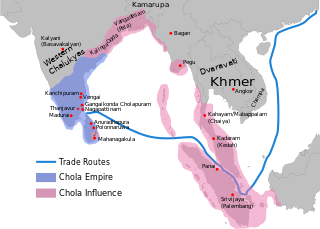
The Chola Empire, which is often referred to as the Imperial Cholas, was a medieval Indian, thalassocratic empire that was established by the Chola dynasty that rose to prominence during the middle of the ninth century and united southern India under their rule.

The Andhra Chodas or Andhra Cholas or Telugu Cholas ruled parts of present-day Andhra Pradesh and Telangana between the 5th and the 13th centuries as samantas of Pallavas and later the Imperial Cholas. Various dynasties exist among them including Velanati, Pottapi, Konidena, Nannuru, Nellore, Kunduru etc. The earliest Choda dynasty in the Telugu area was that of Renati Chodas who ruled Renadu region from late 5th century to 7th century. These Chodas including Renati Chodas claimed descent from the early Sangam Tamil king Karikala Chola. Andhra Chodas contributed much to the early development and evolution of Telugu language and are the first dynasty to use Telugu as their official language in Andhra region. The first and oldest Telugu inscription founded so far is Kalamalla inscription dating to 575 CE put up by Renati Chola king Erikal Mutturaju Dhanunjaya. Andhra Chodas are believed to have been migrated from Tamilakam to Andhra country due to invasion of Tamilakam by Kalabhras and increasing power of Pallavas in northern most part of Tamilakam.

Kulothunga III was a Chola emperor who ruled from 1178 to 1218 CE, after succeeding his elder brother Rajadhiraja II. Kulothunga Chola III gained success in war against his traditional foes. He gained victories in war against the Hoysalas, Pandyas of Madurai, Cheras of Venad, the Sinhalese kings of Polonnaruwa, as well as the Telugu Cholas of Velanadu and Nellore. He also restored Chola control over Karur, which were ruled by the Adigaman chiefs as vassals of the Cholas. He drove out the Hoysalas under Veera Ballala II who had made inroads in the Gangavadi and adjoining areas of Tagadur in Kongu country in an effort expand their territory. However, during the last two years of his reign, he lost in war to the resurgent Pandyas, heralded a period of steady decline and ultimately, demise of the Cholas by 1280 CE. Kulottunga III had alliances with the Hoysalas. The Hoysala king Veera Ballala married a Chola queen called Cholamahadevi and gave his daughter Somaladevi in marriage to Kulottunga III.

Rajendra Chola III came to the Chola throne in 1246 CE. Rajendra began to take effective control over the administration, and epigraphs of Rajendra Chola III indicate there was civil war ending with the death of Rajaraja Chola III. Rajendra's inscriptions laud him as the "cunning hero, who killed Rajaraja after making him wear the double crown for three years".

The region of Tamil Nadu in the southeast of modern India, shows evidence of having had continuous human habitation from 15,000 BCE to 10,000 BCE. Throughout its history, spanning the early Upper Paleolithic age to modern times, this region has coexisted with various external cultures.
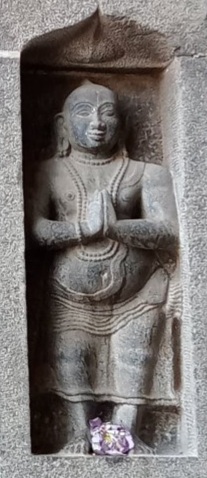
Kopperunchinga II was a Kadava chieftain, who succeeded his father Kopperunchinga I and continued his successes against the Hoysalas. Since the Chola power no longer constituted a threat, Kopperunchinga II acted as the de facto protector of the Chola king and helped him maintain his position on the throne. As he expanded his territorial holdings, Kopperunchinga II assumed such titles as Maharajasimha, Khadgamalla, Kadava Pallava, Alappirandan, Avaniyalappirandan, Kanakasabhapathy, etc. He has left numerous inscriptions mainly in the present Cuddalore, Viluppuram, Mayiladuthurai and Chengalpattu districts and a few have also been found in the erstwhile North Arcot district and Chittoor district. A Thiruvannamalai inscription mentions that he drove the telungar to the north to perish. Ultimately, however, the resurgence of the power of the Pandya kingdom of Madurai ended Kopperunchinga's reign and the Kadava dynasty.

The Tondaiman family were Tamil rulers of the ancient Tondai Nadu (Tondaimandalam) division of Tamilakkam in South India. Their capital was at Kanchipuram.

The Kanchipuram district is in North Tamil Nadu Kanchipuram is believed to have been mentioned in the Tamil epic Manimekhalai.
Tondaiman Ilandiraiyan or Ilamtiraiyan was a ruler of Kanchipuram and a contemporary of the Early Chola king, Karikala. He is traditionally regarded as the founder of the Pallava dynasty. Ilandiraiyan is referred to in the literature of the Sangam period and is the hero of some of the poems in the Pathupattu. He was a poet himself and four of his songs are extant even today. He ruled from Tondaimandalam and was known as 'Tondaman'. According to historian S. Krishnaswami Aiyengar, the Pallavas were natives of Tondaimandalam and the name Pallava is identical with the word Tondaiyar.

Karunakara Tondaiman was a general of Chola Emperor Kulottunga I. He is renowned for leading the Chola invasion of Kalinga during the reign of Kulottunga I and is the hero of Jayamkondar's poem Kalinkkattuparani In the Parani poem he is referred to as the lord of Vandai. while in the Draksharamam inscription of Kulottunga I, he is called as Vanduvaraja and Pallavaraja. He also served as a minister under Kulothunga Chola's son and successor, Vikrama Chola.
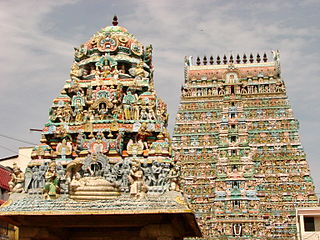
Tamil Nadu is known for its ancient temple architecture. Nearly 33,000 ancient temples, many at least 800 to 2000 years old, are found scattered all over Tamil Nadu. As per Tamil Nadu Hindu Endowments Board, there are 38,615 temples. Most of the largest Hindu Temples are located in Tamil Nadu. Studded with complex architecture, a variety of sculptures, and rich inscriptions, the temples remain the very essence of the culture and heritage of Tamil land, with historical records dating back to at least 3,000 years.

A mandalam was the largest territorial division during the Chola dynasty. At its height, the state was divided into nine mandalams which included areas in Sri Lanka and other conquered areas. The two core mandalams were Chola-mandalam and Jayangondachola-mandalam.

















